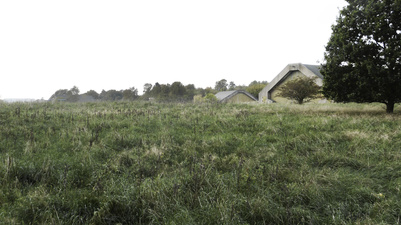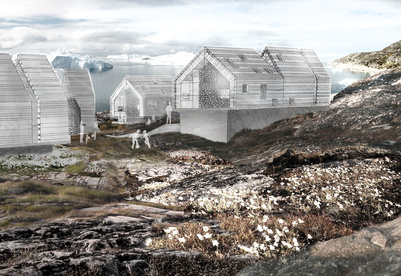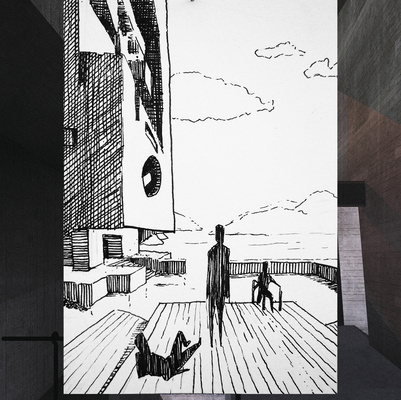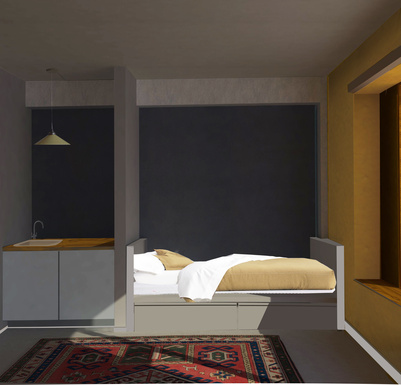The Fundamental Home
My project is an interior concept for a shop for The Fundamental Group in Berlin. The north of Mitte is a residential area, which became a very hip and vibrant district in the past years. Exactly here the design shop will be located. The concept is to slow down the shopping experience and invite the costumer to stay.
My aim was to design a shop, which includes a social environment and provides a surrounding, which can be influenced by the costumer. I want to blur the threshold between exterior and interior because the shop contributes as a mediator between public and private space.
My final project this semester was the design of an interior concept for a retail shop for The Fundamental Group in Berlin.
The Fundamental Group is a Berlin based architecture and design office, which was established in 2010. The founders Stephen Molloy and Gunnar Rönsch share not only their studio, but also their private home, which both are located in a former textile factory in Berlin Mitte. Next to interior fittings, their focus of design lies in daily use objects, like tableware, lamps, decoration etc. They use geometrical structures and principles of repetition as the basis of every product, which shall let the user see their design with the curious eyes of a child.
This means that the user always is supposed to contribute something to their design, as you can see with the Push bowl where you buy a plane metal sheet and have to push yourself the surface how you want it to be. In this way the user builds up an authentic relationship with the object. Most of their products can be purchased for prices below 50 Euros and therefore are perfect gifts.
Localization
The Fundamental Group owns a six storey high building from 1871 in Ackerstraße in Berlin Mitte. This is where their studio and private home is located on the two top floors. It is the intention to realize the shop project on the ground floor of the building in 2016. Still this space is used by a café, which amounts about 60 square meters. The front windows and entrance door are orientated into a westward direction and elevated about two small steps from the street level.
Mitte is the Eastern center of Berlin. It is separated into a northern and southern half by the river Spree. In the south of this district many historic attractions, like the Museum Island or the Brandenburger Gate, are located. Here the building development is more generous, more spacious and luxurious and the most touristic rush takes place here. The north of the Spree is a residential area, characterized by old apartment houses as a perimeter block development. This specific area got more and more popular in the past ten years and got to be one of the districts with the highest rents in Berlin.
The overall gentrification definitely changed the appearance of this area and let it become a very hip and vibrant district. The atmosphere of this neighborhood can be described as relaxed, but still straightforward. This is representative for Berlins’ ambivalence between contemporary and historic. Here lives and works the creative scene next to the old-established Berlin resident. Many young international tourists come here to enjoy fields like architecture, design, fashion, music, food and lifestyle. It is a very inspiring, liberal and lively surrounding. That is why there is a high density of cafés, restaurants, boutiques and other young retail stores in this specific area.
Exactly here the apartment building of The Fundamental Group is located in Ackerstraße. It is a southern side street of Torstraße, in ultimate walking distance to the traffic junction Rosenthaler Platz. The short street leads to a small park, called Koppenplatz, in the south.
When you stroll through the neighborhood, you will notice that the people here really enjoy sitting in front of the shops or cafés. No matter if it’s the owner or costumer. They talk, have a smoke or just watch the street life and actually become a part of it themselves. I personally see a lot of potential in these front seating typologies. They give a very special familiar and charming atmosphere to the district. The direction of seating keeps the view of the people aware of the street life. In this way they are open and interested towards everything happening around them and it is easy to strike up a conversation with them.
Program
Since the title of my thesis is The Fundamental Home, you might ask yourself ‘Where is the home in this project?’ So last semester I tried to investigate how our notion of home changed in the past years, since the whole world got more accessible to us, physically and virtually. Because of that we leave our actual home more and more often for short or long periods, which definitely influences our modern sense of a home. In this context I also examined which factors actually make us feel home. Doing this I came across two, to me most relevant, factors, which are Social Affiliation and Spatial Adoption. Both, when we feel socially integrated and accepted and when we have the opportunity to actively influence and personalize our surrounding, give us the chance to feel home, even away from home.
This is called a third place.
I definitely wanted the third place to influence my design concept. It shall be way more than a just conventional shop, where you go, buy something and leave right away. And it shall create an experience you cannot get online. My concept is to slow down the shopping experience and invite the costumer to stay for a while. So the aim was to design a store, which includes a social environment. The shop should be a place for togetherness and social interaction. It is a meeting point for old and new friends, and connects them on a local level. Here neighbors meet tourists and employees meet creative people to share their experiences with each other. In this way the costumers identify themselves easily with the neighborhood. Another important impact on the costumer has the possibility to adopt the space. Therefore I want to provide a surrounding, which can be influenced, so that the costumers shall interact with the interior and products in a playful way.
Proposal
In the differences between the axonometrics of the existing space and my proposal one can see thatI wanted to revalue the conditions of this small and dark space. That is why I tore down big parts of the middle and back wall of the building, down to eight center and side pillars. I moved the bathroom, kitchen and storage space into the basement, which is available over a staircase behind two doors in the back. Back upstairs, I extended the space via a third spatial sequence in the back and let a part of the backyard become interior space. Three big windows in the new back wall are framed in the axes between the pillars. These allow a direct view from the front of the shop into the garden of the backyard and let a lot of additional daylight into the space.
I want to strongly communicate between street level and indoor because I see the shop as a mediator between public and private space. This is why I continue the concrete flooring from the interior out to the exterior about 60 centimeters extra in the full length of the building and integrate steps in front of the entrance doors. This transformation blurs the threshold between exterior and interior, because the interior floor becomes an outdoor bench. Here the people can find a seat and watch the urban happening, while being part of it. In good weather the two big front windows and the entrance doors can be opened completely, which strengthens the inside-outside connection even more. To people, who walk down the street, the outdoor seating gives an inviting gesture and indicates that here something is happening. The people will easily get intrigued with the interior setting already from a distance.
Once they enter the shop they will notice that this is not a conventional shop. Usually the products of a store are clearly in the center of the attention. Displays and light intensify this setting and give the products the highest importance in it. The products are curated and exhibited.
Interesting about this is, that in most cases the displays are very static, so that the costumers walk around them. There is a static zone for products and a transition zone for costumers. But there is no stay zone. The costumer is held in constant motion, which furthermore makes most shops just a temporary place.
My vision is to use this setting differently. To invite the costumer for a longer stay, the shop provides a landscape of seating accommodation and a drink and snack bar. In my proposal I want the costumer to be in the center of the attention. I want to invite him to sit down next to the products and interact with them in a natural way. The products shall be integrated into the overall atmosphere, so that the costumer gets the opportunity to enjoy them already on location. So for instance, you enjoy a drink out of a glass, and then you can buy and take it home with you.
The interior basically consists of two big inbuilt furniture pieces, which are located at the two sidewalls. The furniture shapes three big steps up against the wall, which spans kind of an open stage space in between, maybe comparable with an amphitheater. The steps contain different kinds of boxes, which can be pulled out. On the lowest level these are longer and have wheels. They can be used as displays for the products and flexibly placed anywhere in the shop. In between these the shopkeepers can find big drawers with storage space. These drawers do not have any handle to hide it from the costumers. The two upper steps contain squared boxes, which are multifunctional. Either it can be used as additional displays, as a table for snacks and drinks or as an additional seat. The flexibility of the boxes allows the costumers to use and place them for their individual demands. The users can set up small moments of intimacy and create their own space. This is how I implement the spatial adoption in my proposal. The appearance of the shop will change and adapt to the changing needs of its costumers and shop keepers. If a lot of empty space is needed for instance, all the boxes can hide underneath the steps. Depending on the event the steps can be used as a seating landscape, while something is happening in the center of the space. Or the steps could be used completely as a display landscape, while the guests crowd in the center and look at the displayed objects. In that way a lot of different events can take place here: product launches, lectures, game nights, exhibitions, concerts etc.
I chose to work with cheap material, which is beech plywood, since the products of the brand The Fundamental Group are also placed in a low priced segment. I want to up value the material and give it an interesting approach in terms of assembling and treatment. That’s why I decided to joint the sheets of plywood in an honest way, without hiding the inner layers, but leave the edges open. In this way the horizontal lines of the furniture get emphasized. I added a light grey tone to the surfaces, to give a subtle, calm and uniform background for the mostly colorful or metal products. Still the texture of the beech shines trough the grey color, which was another important factor to me to treat the material in an honest way.
In the back of the shop I placed three long bar counters next to each other. Here you can find a snack cabinet, an Espresso machine, two fridges for drinks and a lot of storage cupboards on the backside of the counter. For my proposal it was important that there is no hierarchy between the costumers and the shopkeepers. I want them to be on the same level. That’s why I actually left gaps between the counters, to invite the costumers to come behind the bar and serve themselves. Here they can sit on the extra wide windowsill, enjoy the view outside into the backyard or have a chat with someone.
So there is no typical in front and behind the bar, no one who serves you, you do it all yourself. Of course there is someone of the shop who helps you or answers your questions. But even the cash counter has an untypical position for a shop. It is placed between seating and bar in the back on the left side. The costumers stand next to the sales person, side by side, when they want to pay a product. But that is exactly what I want to achieve – that the people get confused and wonder, how different the situations are in this particular shop compared to conventional ones. This is how I want to support them to come into a conversation with each other and experience how important the costumer is in this shop. As I mentioned in the beginning, the user needs to contribute something to the products of The Fundamental Group. So I tried to express this attitude as well towards the interior concept and give the interaction between user, space and product a high importance.
I developed a lighting concept, which shall support my interior proposal. In the center of the ceiling a few LED lines with a neutral white light guide the costumer into the space. These lines get reflected in the front and back windows and visually link interior and exterior. Powerful LED Spotlights highlight the shop windows and products placed in it. All over the shop the same LED Spotlights are placed to flexibly react on the changing positions of displays and therefore follow the products. In the seating and bar area I want to use the different colored metal mesh pendant lamps of The Fundamental Group, which create a warm and cozy ambience with their warm yellow light.
Scenarios
To give you an example, of how a visit at The Fundamental Home could look like, I want to mention two different scenarios. The first one starts with Daniel. It’s his partners’ birthday tomorrow and he is in desperate need of a gift. It should be something special, but cheap since he doesn’t have any money left this month. So he heard about that shop The Fundamental Home and decides to check it out. Already when he walks around the corner from Torstraße into Ackerstraße he sees his old friend Marten hanging out on the front bench of the shop. Marten is having a cup of tea while reading in a magazine. They say hello and have a little chat about the good old times. Daniel enters the shop and has a look around. After a few minutes he finds the Push Bowl as a perfect gift for his partner and buys it. Since this went quite fast he still has some time left for a little snack. He decides for a sandwich and lemonade and joins his friend in front of the shop. After 20 minutes they both leave.
Scenario two starts with Eerika. She recently moved to Berlin and takes a stroll through her new neighborhood. When coming along Ackerstraße she wonders she might get a coffee here. She enters the shop and gets a little confused. Is this a café or a shop? She looks around and sees a girl sitting behind the bar. She asks her if she could please make her a coffee. Marlene replies that she’s a costumer as well and here you kind of have to serve yourself, but of course she could help Eerika with doing the coffee. They get into a small conversation about the concept of the store and some more things. After Eerika finished the coffee, she decides to keep her glass as a memory and buys it. Marlene tells her that she comes here quite often, since she lives around the corner, and that she hopes to see her again. Eerika leaves after 35 minutes and definitely will come back.
Contact
Name Stephanie Meine
Date of birth 5th January 1989
Place of birth Hannover | Germany
Nationality German
Mail stephanie.meine@googlemail.com
Education
08-2013 to 06-2015:
Master at The Royal Danish Academy of Fine Arts | Copenhagen | Denmark Department for furniture design and space
09-2012 to 03-2013:
Internship at Thomas Baecker Architekt | Berlin
10-2008 to 07-2012:
Bachelor of Science in Architecture | Leibniz Universität Hannover | Germany
04-2012 to 07-2012:
Scientific Assistance of Prof. Hilde Léon Department for design and building theory | Leibniz Universität Hannover | Germany
07-2011 to 10-2011:
Internship as Photography Assistance at Robert Wunsch | Berlin
08-2010 to 07-2011:
Year abroad at Escuela Técnica Superior de Arquitectura | Madrid | Spain
2001 to 2008:
Secondary School Kaiser- Wilhelm- & Ratsgymnasium | Hannover | Germany
1999 to 2001:
Middle School Orientierungsstufe Birkenstraße | Hannover
1995 to 1999:
Elementary School Grundschule Arnum | Hannover
Languages
- German native
- English C1
- Spanish B1
- Danish 2
Skills
Adobe Photoshop | Illustrator | Indesign
Bridge | Camera Raw ArchiCad | Allplan
Word | Excel | PowerPoint Rhino | Vray































